As you immerse yourself in the captivating world of wild cats, you will find yourself surrounded by a tapestry of colors, patterns, and untamed beauty. From the dense jungles to the vast plains, these enigmatic creatures roam with a grace that is both captivating and mysterious.
But what lies beyond the surface? What secrets do these elusive felines hold? Join us as we unravel the mysteries and explore the diverse array of wild cats that inhabit our planet, leaving you eager to uncover the wonders that await.
Ocelot, Caracal, Cougar
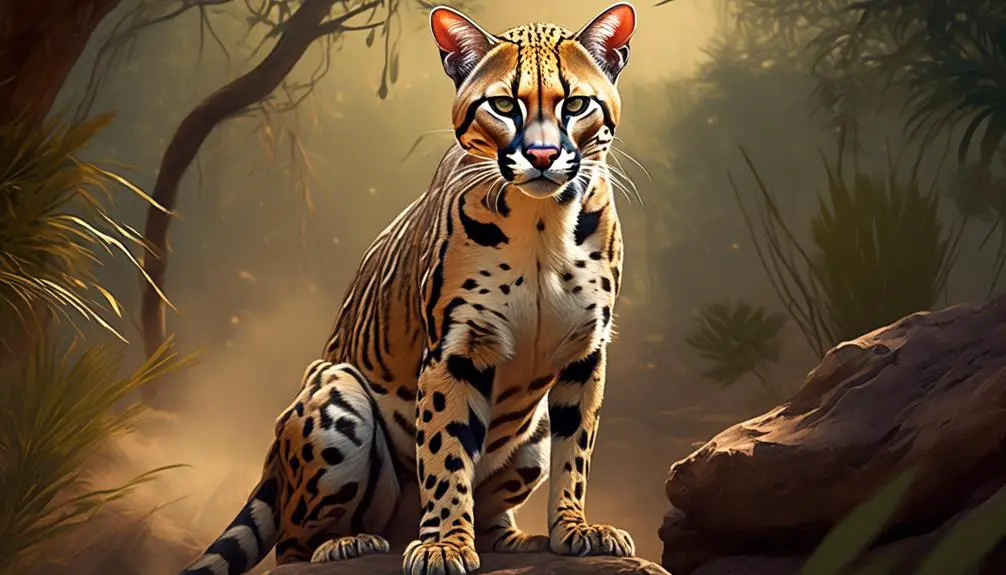
Ocelot, Caracal, and Cougar are three distinct species of wild cats found in different habitats across the Americas, each possessing unique characteristics and adaptations.
The Ocelot (Leopardus pardalis) weighs between 15 and 30 pounds and primarily inhabits subtropical and tropical forests, grasslands, and marshlands. This endangered species is known for its leopard-like grace and beautiful spots.
The Caracal (Caracal caracal) weighs between 18 and 42 pounds and can be found in deserts, prairies, and scrublands. These striking small cats have reddish-golden fur and long elf-like ears. Although they can be kept as exotic pets, they’re known to be antisocial and destructive.
The Cougar (Puma concolor), also known as the puma or mountain lion, weighs between 100 and 125 pounds and is endemic to mountainous regions across the Americas. Found in mountains and forests, the cougar is a powerful predator. Its adaptability and wide distribution make it one of the most successful wild cats in the Americas.
These three species exhibit exceptional adaptations that allow them to thrive in their respective habitats.
Lynx
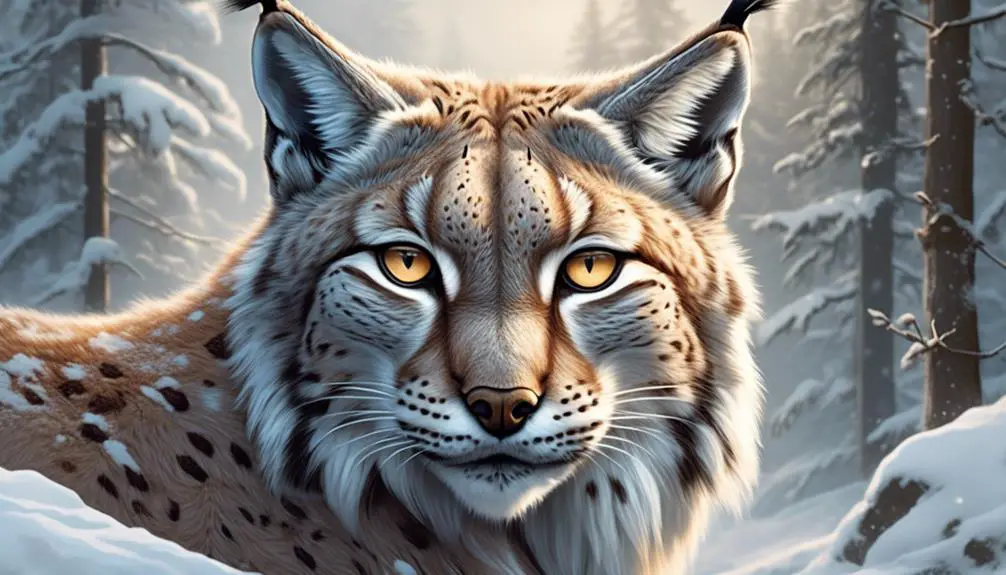
Now let’s turn our attention to the intriguing Lynx.
Lynx are medium-sized wild cats that can weigh between 20 and 60 pounds. They inhabit boreal forests and high-altitude forests, and there are four distinct varieties: the Iberian Lynx, Eurasian Lynx, Canadian Lynx, and Bobcat.
The Bobcat is the smallest lynx, while the Canadian Lynx is the largest.
Lynx Varieties and Characteristics
The lynx, a type of wild cat, encompasses four distinct varieties, including the Iberian Lynx, Eurasian Lynx, Canadian Lynx, and Bobcat.
The Iberian Lynx (Lynx pardinus) is the most endangered wild cat species in the world, with a population of less than 100 individuals. It’s found primarily in the Iberian Peninsula, inhabiting Mediterranean forests and scrublands.
The Eurasian Lynx (Lynx lynx) is the largest lynx species, weighing up to 88 pounds. It’s distributed across Europe and Asia, inhabiting boreal forests and high-altitude regions.
The Canadian Lynx (Lynx canadensis) is native to North America, ranging from Alaska to Newfoundland. It’s well adapted to cold climates and preys mainly on snowshoe hares.
The Bobcat (Lynx rufus) is the smallest lynx species, weighing around 20 pounds. It’s found throughout North America, inhabiting a variety of habitats, including forests, deserts, and grasslands.
Lynx Conservation Efforts
Conservation efforts for lynx species have been implemented to protect and preserve their populations in their respective habitats. These efforts aim to mitigate the threats that endanger the survival of lynx species, such as habitat loss, poaching, and climate change. The table below provides a summary of the conservation status and key conservation efforts for the four distinct lynx varieties:
| Lynx Variety | Conservation Status | Conservation Efforts |
|---|---|---|
| Iberian Lynx | Critically Endangered | Habitat restoration, captive breeding programs |
| Eurasian Lynx | Least Concern | Protected area management, monitoring populations |
| Canadian Lynx | Least Concern | Sustainable forest management, habitat conservation |
| Bobcat | Least Concern | Wildlife corridors, education and public awareness |
These conservation efforts play a crucial role in ensuring the long-term survival of lynx species and maintaining the ecological balance in their habitats. By implementing these measures, we can contribute to the preservation of these magnificent wild cats for future generations.
Serval, African Wildcat
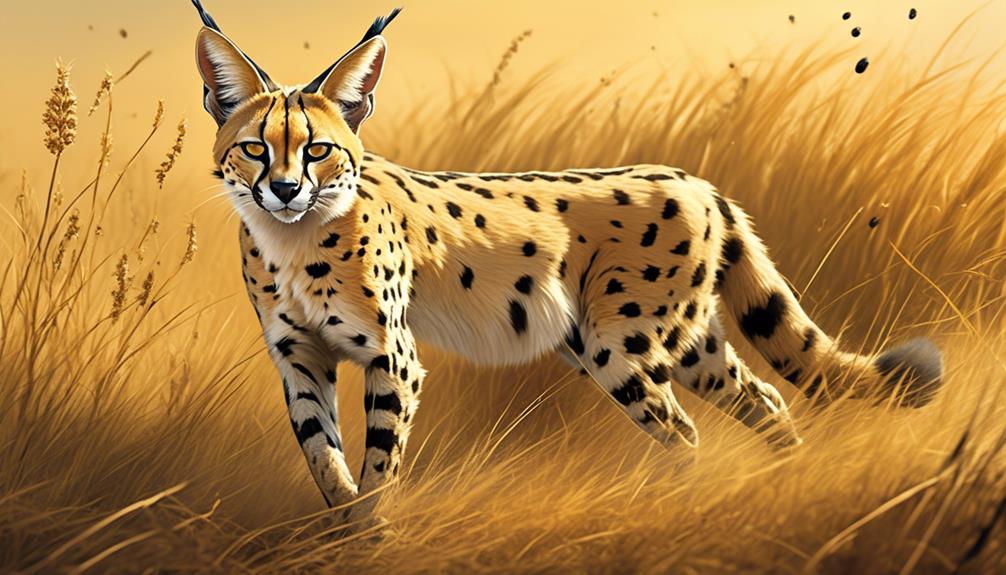
The Serval and African Wildcat are two distinct species of wild cats found in different regions but share common characteristics.
The Serval (Leptailurus serval) is a medium-sized African wild cat with a slender body and long legs. It weighs between 20 and 40 pounds and is mainly found in grassy plains and savannahs. The Serval has a small head resembling that of a house cat, but its body is lankier, allowing it to navigate through tall grasses with ease. Its natural habitat consists of moorlands, savannahs, and grasslands.
On the other hand, the African Wildcat (Felis lybica) is a widespread wild cat found in Africa and Asia. It weighs between 6 and 14 pounds and is known to share a common ancestor with domesticated cats. The African Wildcat has adapted to various environments, including savannahs, deserts, scrublands, and open forests.
Both the Serval and African Wildcat possess sharp hearing and excellent vision, allowing them to hunt small mammals and birds. They’re solitary animals and have a nocturnal hunting behavior.
Despite their similarities, their physical appearances and habitats differ, highlighting the rich diversity of wild cat species in different regions of the world.
Kodkod, Snow Leopard
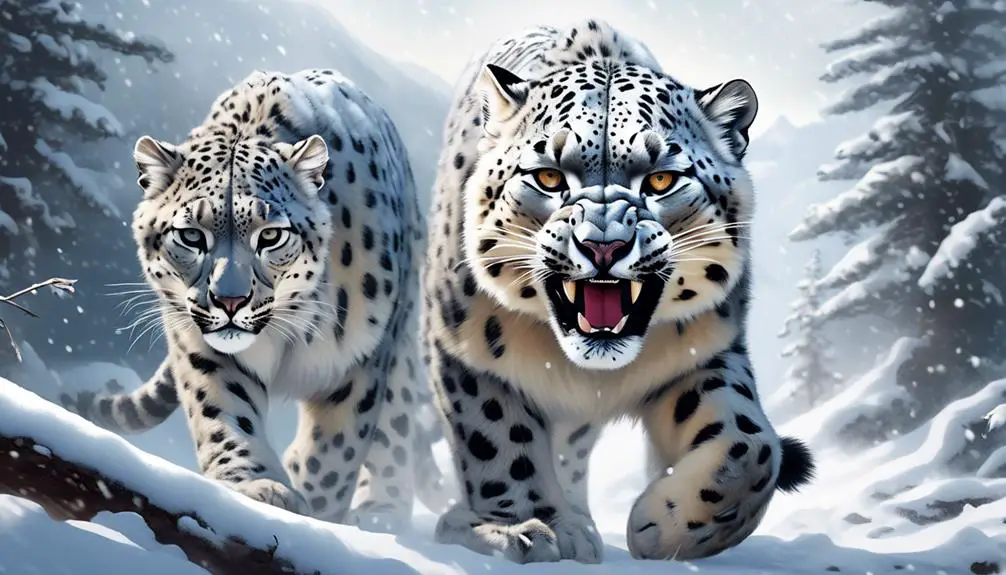
Next, let’s explore the fascinating world of the Kodkod and Snow Leopard.
The Kodkod, the smallest wildcat native to the Americas, can be found exclusively in the Andean regions of Chile and Argentina.
In contrast, the Snow Leopard, a large cat native to mountainous regions of Asia, faces severe threats from poaching and habitat destruction.
These two wildcats showcase unique adaptations and are of great conservation concern.
Andean Native Wildcat
An Andean native wildcat, known as the Kodkod, is the smallest wildcat native to the Americas, weighing between 4.4 and 5.5 pounds. It’s found exclusively in the Andean regions of Chile and Argentina.
The Kodkod inhabits temperate forests, rainforests, and coastal hills/mountains. It has a stout body, short legs, and a small head with rounded ears. Its fur is grayish-brown with dark spots and stripes, providing camouflage in its forested habitat.
The Kodkod is a solitary and elusive predator, feeding on small mammals, birds, and reptiles.
Due to habitat loss and fragmentation, the Kodkod population is declining, and it’s currently classified as Near Threatened by the International Union for Conservation of Nature (IUCN).
Conservation efforts are crucial to ensure the survival of this unique Andean wildcat.
Endangered Snow Leopard
As we shift our focus to the endangered snow leopard, a remarkable wildcat known for its elusive nature and stunning adaptations, we delve into the challenges this majestic species faces in its alpine and subalpine habitats.
The snow leopard (Panthera uncia) is a large cat native to the mountainous regions of Asia. It’s well-adapted to its harsh environment, with thick fur and a long tail that provides balance.
However, the snow leopard is currently facing numerous threats to its survival. Poaching for its fur and body parts, as well as habitat destruction due to human activities, have severely impacted its population.
Conservation efforts are being made to protect this iconic species, but more needs to be done to ensure its long-term survival in the wild.
Unique Habitat Adaptations
The Kodkod and the Snow Leopard are wild cats that have developed unique adaptations to thrive in their respective habitats.
The Kodkod, the smallest wildcat native to the Americas, is found exclusively in the temperate forests, rainforests, and coastal hills/mountains of the Andean regions of Chile and Argentina. To navigate its dense forest habitat, the Kodkod has evolved a slender body and short legs, allowing it to move swiftly through the undergrowth. Additionally, its small size enables it to hunt smaller prey, such as rodents and birds, which are abundant in its habitat.
On the other hand, the Snow Leopard, a large cat native to the mountainous regions of Asia, has adapted to the harsh alpine and subalpine environments. It possesses a thick, insulating coat that helps it withstand extreme cold temperatures, while its large paws provide better traction on snow-covered terrain. The Snow Leopard’s long, muscular tail serves as a balance aid when traversing steep slopes and rocky terrain.
These unique habitat adaptations allow both the Kodkod and the Snow Leopard to survive and thrive in their respective environments.
European Wildcat, Fishing Cat
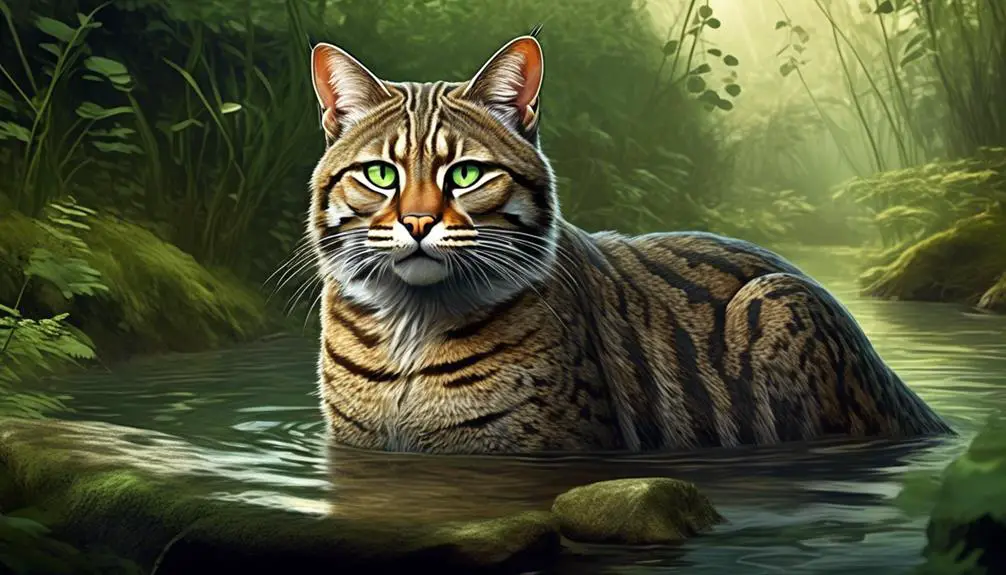
The European Wildcat and the Fishing Cat are two distinct species of wildcats with unique characteristics and natural habitats.
The European Wildcat (Felis silvestris) is a medium-sized wildcat weighing between 6 and 18 pounds. It’s primarily found in forests and grasslands across Europe. This fluffy wildcat is known for its thick fur and bushy tail. However, the pure populations of European Wildcats are being affected by suspected crossbreeding with stray and feral cats.
On the other hand, the Fishing Cat (Prionailurus viverrinus) is a skilled swimmer with partially webbed paws. It weighs between 13 and 26 pounds and is mainly found in swamps and wetlands in Southeast Asia. The Fishing Cat’s natural habitat provides it with ample opportunities to hunt for fish, birds, reptiles, and small mammals. Its partially webbed paws make it easier for the Fishing Cat to navigate through the water and catch its prey.
Both the European Wildcat and the Fishing Cat have adapted to their specific environments, developing characteristics that aid in their survival. Understanding these unique wildcats and their habitats is crucial for conservation efforts and ensuring their continued existence in the wild.
African Golden Cat, Pampas Cat
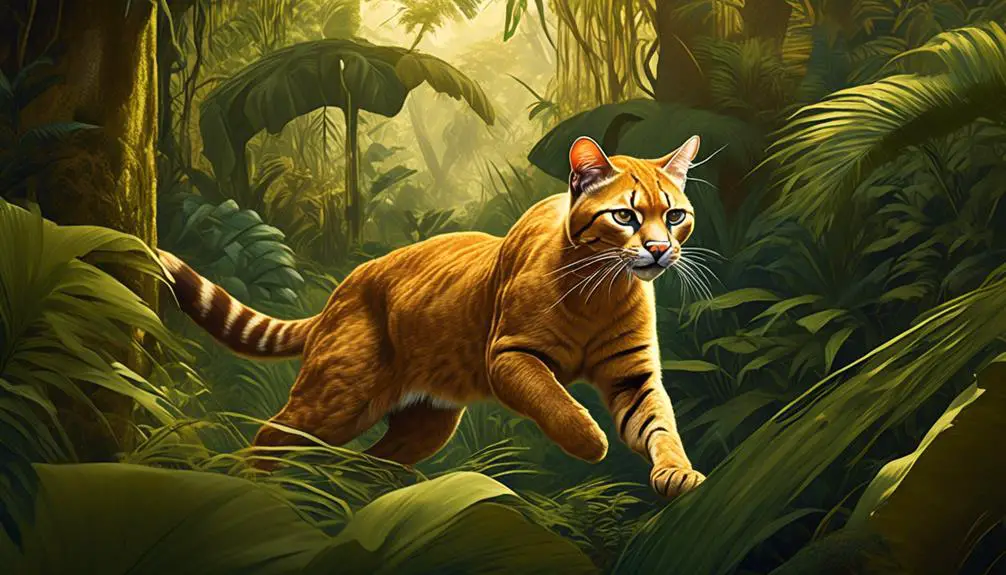
Crossing continents, we now turn our attention to the African Golden Cat and the Pampas Cat, two distinct wildcat species each with their own unique characteristics and habitats.
The African Golden Cat (Caracal aurata) is closely related to the Serval and Caracal. It weighs between 13 and 30 pounds and is primarily found in moorlands, savannahs, and grasslands. Unfortunately, the African Golden Cat is threatened by poaching and habitat destruction.
On the other hand, the Pampas Cat (Leopardus colocolo), also known as Colocolo, weighs between 20 and 40 pounds and shares a similar natural habitat with the African Golden Cat, including moorlands, savannahs, and grasslands. However, the Pampas Cat is unique in its ability to climb trees and its preference for high-altitude habitats.
Both the African Golden Cat and the Pampas Cat play important roles in their respective ecosystems. They help control populations of small mammals and contribute to the overall biodiversity of their habitats. However, their populations are currently at risk due to human activities.
Conservation efforts are crucial to ensuring the survival of these two wildcat species. Protecting their habitats and implementing measures to combat poaching are essential steps in safeguarding the future of the African Golden Cat and the Pampas Cat.
Amur Leopard, Marbled Cat
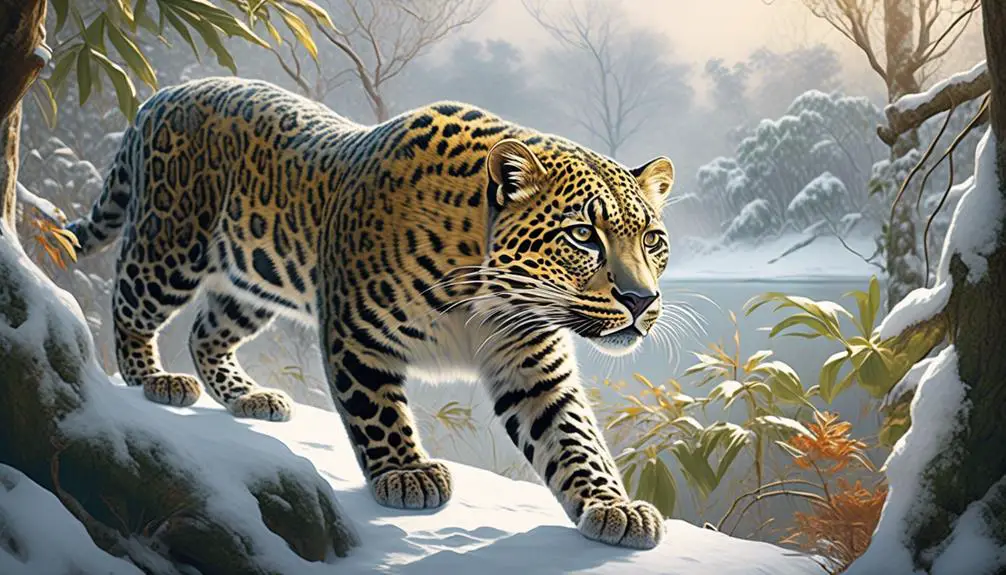
The Amur Leopard and the Marbled Cat are two unique wildcat species with distinct characteristics and habitats.
The Amur Leopard, scientifically known as Panthera pardus orientalis, is a critically endangered wildcat found in Far East Russia and parts of China. Weighing between 50 and 100 pounds, the Amur Leopard is adapted to snowy environments and inhabits snowy forests and mountains. Its fur is pale and thick, providing insulation against the cold. The Amur Leopard is known for its agility and stealth, making it an efficient hunter. Unfortunately, due to poaching and habitat destruction, the population of Amur Leopards has drastically decreased, with only around 100 individuals remaining in the wild.
On the other hand, the Marbled Cat, or Pardofelis marmorata, is a small wildcat weighing between 5 and 11 pounds. Its natural habitat is moorlands in Southeast Asia. The Marbled Cat is characterized by its unique fur pattern, which consists of irregular blotches and stripes, providing excellent camouflage in its forested environment. This elusive cat is known for its arboreal lifestyle, spending much of its time in trees. The Marbled Cat has a slender body and long tail, which aids in its balance and agility while navigating the treetops. Due to habitat loss and fragmentation, the Marbled Cat population is declining, and it’s currently classified as near threatened.
Sand Cat, Cheetah, Jaguar, Tiger, Lion
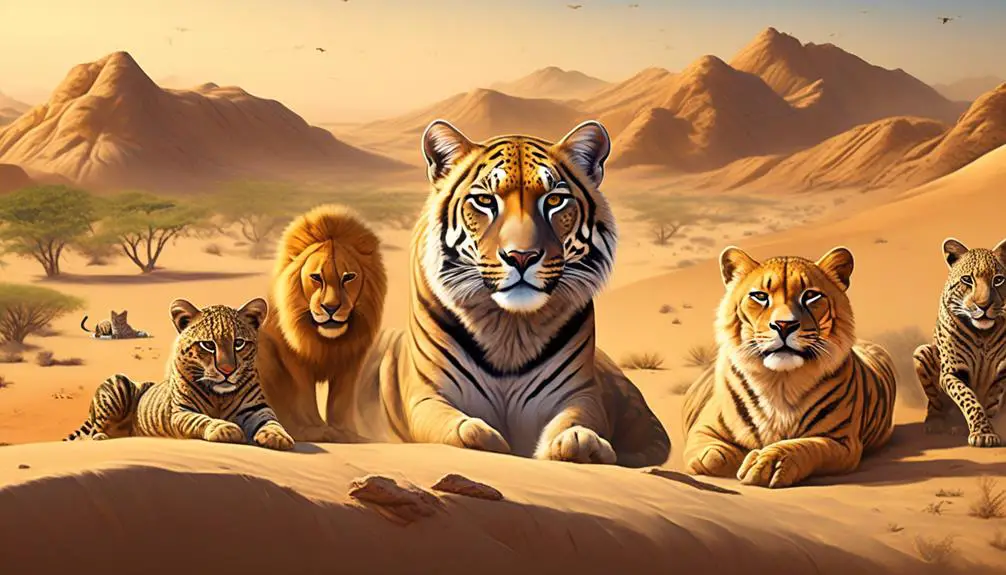
As we move on to discuss the subtopic of Sand Cat, Cheetah, Jaguar, Tiger, and Lion, it’s important to shift our focus to the diverse range of wildcat species that inhabit various landscapes and exhibit unique characteristics.
The Sand Cat (Felis margarita) is a medium-sized wildcat weighing between 20-40 pounds. It thrives in its natural habitat of moorlands, savannahs, and grasslands. Adapted to desert life, this cat has plush, dense coats that protect it from the night chill in the desert. Its thick black paws are resistant to hot sands and stones, allowing it to navigate its arid environment with ease.
The Cheetah (Acinonyx jubatus), on the other hand, is the fastest land animal, capable of reaching speeds up to 70 miles per hour. Weighing between 77-143 pounds, it primarily inhabits grasslands and savannahs. Cheetahs are known for their unique black ‘tear marks’ on their face, which help to reduce glare from the sun and aid in hunting.
Moving on to the Jaguar (Panthera onca), we encounter the largest cat species in the Americas. Weighing between 100-250 pounds, Jaguars are found in rainforests, swamps, and grasslands. They possess a powerful bite, capable of crushing turtle shells, which enables them to prey on a wide range of animals.
The Tiger (Panthera tigris) takes the crown as the largest cat species, weighing between 200-670 pounds. These majestic creatures inhabit forests, grasslands, and mangroves. Known for their strength and agility, tigers are endangered, with an estimated population of less than 4,000 in the wild.

Erzsebet Frey (Eli Frey) is an ecologist and online entrepreneur with a Master of Science in Ecology from the University of Belgrade. Originally from Serbia, she has lived in Sri Lanka since 2017. Eli has worked internationally in countries like Oman, Brazil, Germany, and Sri Lanka. In 2018, she expanded into SEO and blogging, completing courses from UC Davis and Edinburgh. Eli has founded multiple websites focused on biology, ecology, environmental science, sustainable and simple living, and outdoor activities. She enjoys creating nature and simple living videos on YouTube and participates in speleology, diving, and hiking.

